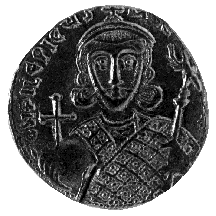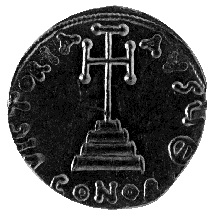



(140) Philippicus (Bardanes) - AV solidus, A.D. 711-713, 4.33
g. (inv. 91.281).
Obverse: Facing crowned bust of Philippicus, wearing loros and holding
globus cruciger in r.
and scipio in l.; D(OMINVS) N(OSTER) FILEPICVS MV[LTOS ANNOS]: Our
lord Philippicus, many years.
Reverse: Cross potent on four steps; VICTORIA AVGV(STI) ![]() : Victory of
the Augustus, officina mark
: Victory of
the Augustus, officina mark ![]() ; in exergue, CONOB: gold of Constantinople.
; in exergue, CONOB: gold of Constantinople.
Provenance: Hesperia Art, 1959.
Bibliography: W. Wroth, Catalogue of the Imperial Byzantine Coins in
the British Museum (London 1908) 6; P. Grierson, Byzantine Coins
(London 1982).
In the course of the revolts that brought down Justinian II, an Armenian
named Bardanes was proclaimed emperor; he changed his name to Philippicus.
Philippicus subscribed to heretical views and made himself an enemy of the
Pope by removing an image of a council of the Church that had condemned
these views some years earlier. In the destruction of this religious image
he foreshadowed the greater iconoclastic controversies to come, which were
ignited by opposition to the cult of icons, or images of religious figures,
and the superstitious practices they could encourage. These beliefs probably
also led Philippicus to reject the bust of Christ that Justinian II had
introduced to Byzantine coinage and to revert to the portrait of the emperor
on the obverse of his coins and the cross on the steps on the reverse.
The portrait of Philippicus introduces a somewhat longer hairstyle for the
emperor, but is otherwise as stylized as those of his predecessors. This
is the last time that the scipio, the eagle-tipped consular scepter
that he holds in his left hand, appeared on Byzantine coins. The acclamation
multos annos, "may he rule for many years," was used at
imperial processions and ceremonies and replaced perpetuus augustus
on the coins of this period.
R.K.B.



All contents copyright (c) 1996.
Lawrence University
All rights reserved.